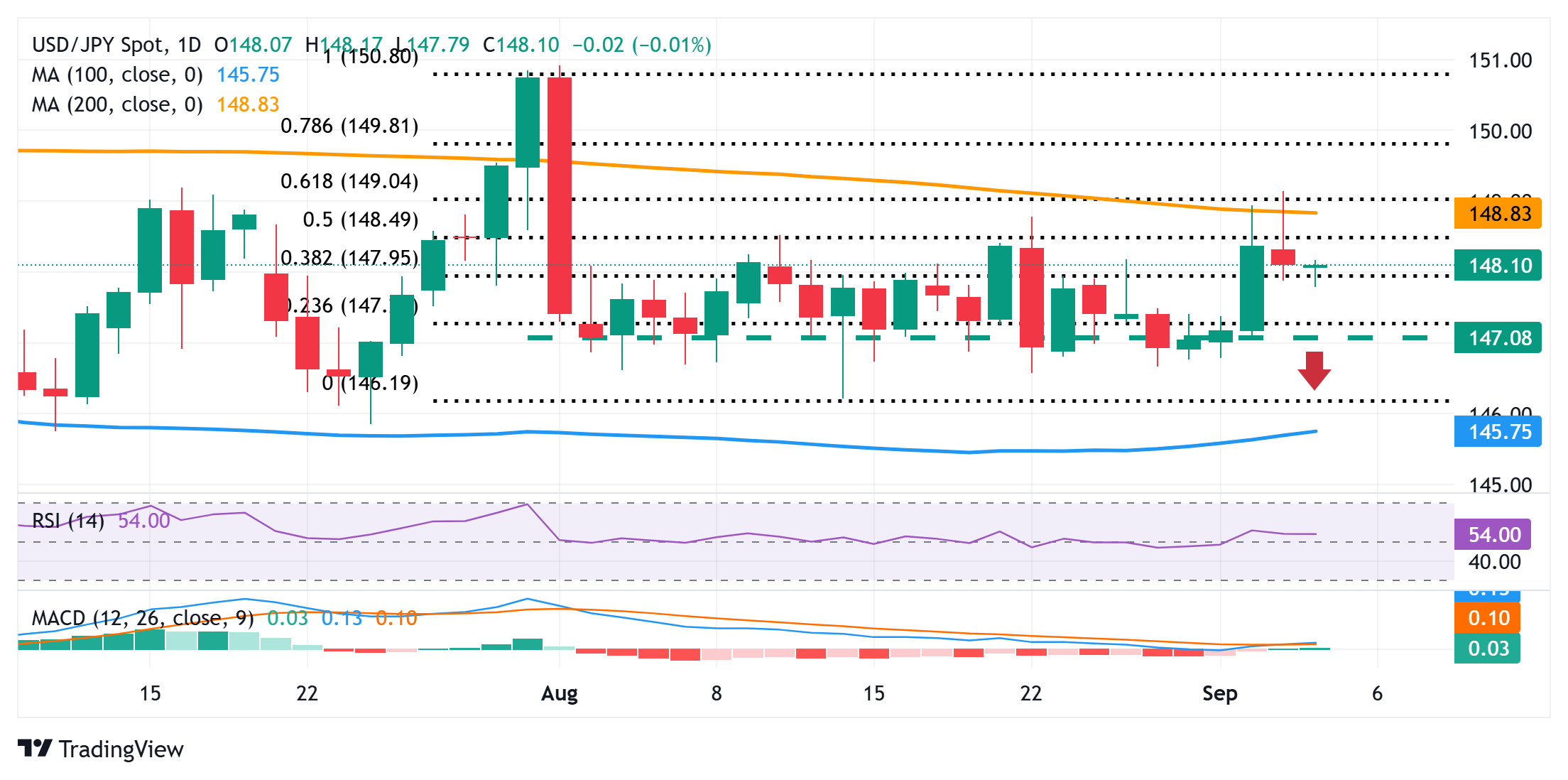Created
: 2025.09.04














![]() 2025.09.04 11:32
2025.09.04 11:32
The Japanese Yen (JPY) struggles to capitalize on its recovery from a one-month trough touched against its American counterpart the previous day and oscillates in a narrow range during the Asian session on Thursday. Market participants remain divided over the likely timing and pace of Bank of Japan (BoJ) rate hikes amid tariff-related uncertainties. Furthermore, the recent surge in global bond yields has shifted focus again to rising debt levels across major economies, including Japan, which, along with domestic political uncertainty, holds back the JPY bulls from placing aggressive bets.
Adding to this, a stable performance around the equity markets is seen as another factor acting as a headwind for the safe-haven JPY. Meanwhile, expectations that wages are set to rise further in a tight labor market, which, in turn, could fuel demand-driven inflation, keep the door open for additional BoJ tightening. In contrast, the US Federal Reserve (Fed) is widely expected to lower borrowing costs later this month, and the bets were reaffirmed by softer US JOLTS Job Openings data on Wednesday. This keeps the US Dollar (USD) bulls on the defensive and might continue to support the JPY.

The overnight failure to build on momentum beyond the 200-day Simple Moving Average (SMA) and a sharp pullback from the 61.8% Fibonacci retracement level of the downfall from the August monthly swing high favour the USD/JPY bears. That said, positive oscillators on the daily chart make it prudent to wait for acceptance below the 148.00 mark before positioning for deeper losses. Spot prices might then accelerate the fall to the 147.40 intermediate support en route to the 147.00 mark and the 146.70 horizontal zone. A convincing break below the latter would expose the August swing low, around the 146.20 region, before spot prices eventually test the 146.00 mark.
On the flip side, a positive move back above the 148.30-148.25 static barrier could lift the USD/JPY pair back towards the 200-day SMA, currently pegged near the 148.75-148.80 region. Some follow-through buying, leading to a subsequent strength beyond the 149.00 mark and the 149.20 area, or the 61.8% Fibo. retracement level, will be seen as a fresh trigger for bulls. Spot prices might then aim to reclaim the 150.00 psychological mark. The momentum could extend further towards challenging the August monthly swing high, around the 151.00 neighborhood.
The Bank of Japan (BoJ) is the Japanese central bank, which sets monetary policy in the country. Its mandate is to issue banknotes and carry out currency and monetary control to ensure price stability, which means an inflation target of around 2%.
The Bank of Japan embarked in an ultra-loose monetary policy in 2013 in order to stimulate the economy and fuel inflation amid a low-inflationary environment. The bank's policy is based on Quantitative and Qualitative Easing (QQE), or printing notes to buy assets such as government or corporate bonds to provide liquidity. In 2016, the bank doubled down on its strategy and further loosened policy by first introducing negative interest rates and then directly controlling the yield of its 10-year government bonds. In March 2024, the BoJ lifted interest rates, effectively retreating from the ultra-loose monetary policy stance.
The Bank's massive stimulus caused the Yen to depreciate against its main currency peers. This process exacerbated in 2022 and 2023 due to an increasing policy divergence between the Bank of Japan and other main central banks, which opted to increase interest rates sharply to fight decades-high levels of inflation. The BoJ's policy led to a widening differential with other currencies, dragging down the value of the Yen. This trend partly reversed in 2024, when the BoJ decided to abandon its ultra-loose policy stance.
A weaker Yen and the spike in global energy prices led to an increase in Japanese inflation, which exceeded the BoJ's 2% target. The prospect of rising salaries in the country - a key element fuelling inflation - also contributed to the move.
![]()
Created
: 2025.09.04
![]()
Last updated
: 2025.09.04

FXStreet is a forex information website, delivering market analysis and news articles 24/7.
It features a number of articles contributed by well-known analysts, in addition to the ones by its editorial team.
Founded in 2000 by Francesc Riverola, a Spanish economist, it has grown to become a world-renowned information website.
We hope you find this article useful. Any comments or suggestions will be greatly appreciated.
We are also looking for writers with extensive experience in forex and crypto to join us.
please contact us at [email protected].
Disclaimer:
All information and content provided on this website is provided for informational purposes only and is not intended to solicit any investment. Although all efforts are made in order to ensure that the information is correct, no guarantee is provided for the accuracy of any content on this website. Any decision made shall be the responsibility of the investor and Myforex does not take any responsibility whatsoever regarding the use of any information provided herein.
The content provided on this website belongs to Myforex and, where stated, the relevant licensors. All rights are reserved by Myforex and the relevant licensors, and no content of this website, whether in full or in part, shall be copied or displayed elsewhere without the explicit written permission of the relevant copyright holder. If you wish to use any part of the content provided on this website, please ensure that you contact Myforex.
Myforex uses cookies to improve the convenience and functionality of this website. This website may include cookies not only by us but also by third parties (advertisers, log analysts, etc.) for the purpose of tracking the activities of users. Cookie policy